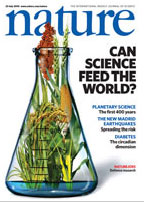
鸟类和哺乳动物有鲜明的性染色体。在鸟类中,雄性个体有一对Z染色体,而雌性个体有一个Z染色体和一个W染色体。在哺乳动物中,雄性个体的染色体是XY,雌性是XX。人们长期假设,性染色体演化涉及性特异性染色体(即W染色体和Y染色体)的巨大改变,但两性都有的Z染色体和X染色体只发生较小的改变。但根据一项新的研究,事实并不是这样的。
这项研究报告了鸡的Z染色体的序列,并将其与已完成测序的人X染色体序列进行了比较。Z染色体和X染色体与产生它们的常染色体(非性染色体)相比发生了巨大变化。而且Z染色体和X染色体似乎是遵从收敛的演化轨迹,包括由睾丸所表达的基因家族的获得和放大,尽管它们是从先祖基因组的不同部分独立形成的。(生物谷Bioon.com)
生物谷推荐原文出处:
Nature doi:10.1038/nature09172
Convergent evolution of chicken Z and human X chromosomes by expansion and gene acquisition
Daniel W. Bellott,Helen Skaletsky,Tatyana Pyntikova,Elaine R. Mardis,Tina Graves,Colin Kremitzki,Laura G. Brown,Steve Rozen,Wesley C. Warren,Richard K. Wilson" David C. Page
In birds, as in mammals, one pair of chromosomes differs between the sexes. In birds, males are ZZ and females ZW. In mammals, males are XY and females XX. Like the mammalian XY pair, the avian ZW pair is believed to have evolved from autosomes, with most change occurring in the chromosomes found in only one sex―the W and Y chromosomes1, 2, 3, 4, 5. By contrast, the sex chromosomes found in both sexes―the Z and X chromosomes―are assumed to have diverged little from their autosomal progenitors2. Here we report findings that challenge this assumption for both the chicken Z chromosome and the human X chromosome. The chicken Z chromosome, which we sequenced essentially to completion, is less gene-dense than chicken autosomes but contains a massive tandem array containing hundreds of duplicated genes expressed in testes. A comprehensive comparison of the chicken Z chromosome with the finished sequence of the human X chromosome demonstrates that each evolved independently from different portions of the ancestral genome. Despite this independence, the chicken Z and human X chromosomes share features that distinguish them from autosomes: the acquisition and amplification of testis-expressed genes, and a low gene density resulting from an expansion of intergenic regions. These features were not present on the autosomes from which the Z and X chromosomes originated but were instead acquired during the evolution of Z and X as sex chromosomes. We conclude that the avian Z and mammalian X chromosomes followed convergent evolutionary trajectories, despite their evolving with opposite (female versus male) systems of heterogamety. More broadly, in birds and mammals, sex chromosome evolution involved not only gene loss in sex-specific chromosomes, but also marked expansion and gene acquisition in sex chromosomes common to males and females.







